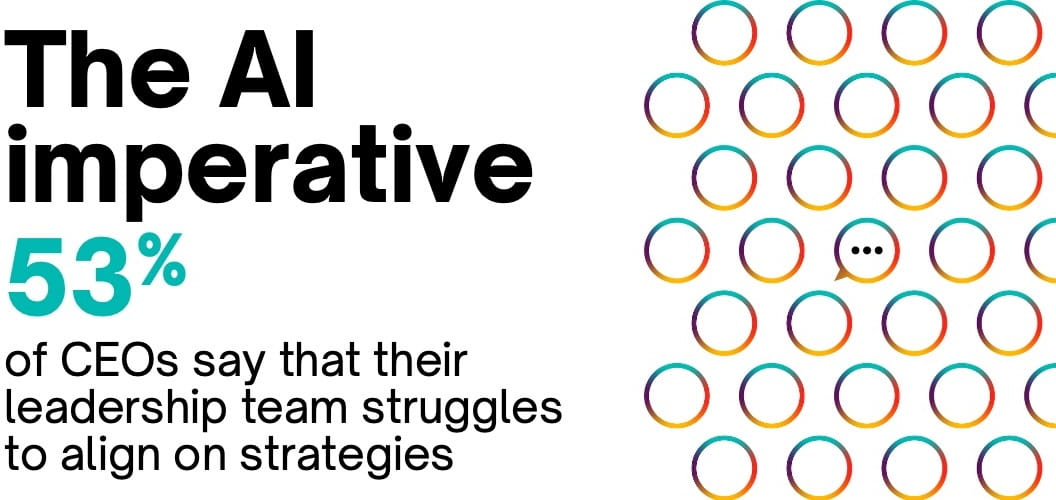Seismic AI shifts will be front-and-centre in the world of work in the next five years. But as leaders strive for business growth in the age of AI, they can’t afford to overlook their people.
The Adecco Group’s latest Business Leaders research, Leading in the age of AI: Expectations versus reality finds that, to stay competitive, organisations must rebalance their talent and technology strategies so that tech can underpin a human-centric and future-ready business. The research, based on insights from 2,000 C-suite executives across 13 countries, reveals a growing gap between leadership ambition and execution. CEOs recognise the pressing challenge, but talent strategies remain misaligned, skills shortages persist, and many companies lack a clear roadmap for the future. Instead, they are expecting their workers to adapt to AI without providing them with the training, support or ethical framework needed to manage the transition.
In contrast, future-ready organisations position human-centricity and adaptability as cornerstones of talent strategy in the age of AI. This new cohort of companies distinguishes itself by sustaining a culture of agility and mobility. How? First, by embracing a workforce planning approach that views upskilling and career mobility as two sides of the same coin. Second, by positioning technology at the core of a reimagined workforce strategy. Most importantly, they do all of this while remaining human-centric.

Divided leadership and unfair expectations
Leaders agree that AI and digital transformation will be the dominant trends by 2030, yet many struggle to align talent strategies accordingly. More than half (53%) of CEOs say leadership misalignment on strategy stalls progress, while less than half of companies have an effective strategy for forecasting skills gaps.
Daniela Seabrook, CHRO at The Adecco Group, said in a special C-Suite Table Talk about the research that companies can no longer treat technology and talent strategies as separate entities: “Melding the human and the technology parts into one is at the core of the business strategy. That’s why the partnership between the CHRO and the CTO needs to be redefined.”
However, confidence in AI implementation is wavering, with leaders’ trust in their company’s AI strategy falling from 69% last year to 58% today. This growing uncertainty means leaders acknowledge the urgency of AI but struggle to align on execution. Without decisive leadership and a commitment to workforce development, organisations risk falling behind as AI reshapes the business landscape. Can leaders look beyond technology and position their organisation – and their workers – for this disruption?
Paradoxically, despite this indecision at the top, a striking 60% of organisations expect employees to update their skills, roles, and responsibilities to keep pace with AI. However, only 25% of workers report receiving AI training, leaving a significant portion of the workforce unprepared for technological shifts.

Future-ready organisations: A new playbook for success
According to our framework, 10% of companies are future-ready, proactively transforming their workforce while others struggle with AI adaptation. They rank agility as the most valuable leadership skill – whereas other survey respondents prioritise AI and technology skills – and two-thirds of them (65%) are shifting from a jobs-based to a skills-based workforce planning approach.
“For a long time, leadership was defined by the person who has the answers,” explained Seabrook. “But in the future, an AI will have much more information, so we will move from having the right answers to having the right questions and then iterating on that.”
By fostering adaptability and continuous learning, future-ready organisations position themselves ahead of the curve.
Closing the gap between expectations and reality
For businesses to make tangible progress and deliver on their potential, leaders must take decisive steps. Our survey found that the number one barrier to accelerating digital transformation is technology and digital skills scarcity . Workforce data insights would provide a better view of available skills and make it easier to create a plan, but only a third of organisations are currently investing.
A lack of structured guidance leaves employees to navigate AI alone. But companies with a responsible AI framework take a different approach: 65% actively upskill their workforce, compared with just 51% of those without one. Those with a responsible AI framework are also more likely to set clear expectations and create accountability for AI implementation – and they’re seeing better results.
The importance of guidance and collaboration was highlighted in the Table Talk by Natalia Wallenberg, CHRO at Ahold Delhaize: “As technology evolves, we should pay extra attention to how we help our colleagues and leaders, as well as how we learn, coach each other, give each other feedback, and create an environment where people can feel safe and well and engaged.”
Thriving in an AI-driven future
AI is reshaping industries, but the greatest challenge for businesses isn’t the technology itself, it’s how they respond. Companies that align leadership, invest in workforce adaptability, and adopt an ethical approach will emerge stronger. Those that fail to act risk being left behind, as future-ready organisations set the pace for evolution.
Many businesses hesitate on AI, but waiting for certainty isn’t an option. “We need to give up perfectionism when planning. Nobody has a crystal ball,” affirmed Wallenberg. “Knowing 80% is better than knowing 20%, so we need to be comfortable making bets and predictions, rather than doing nothing at all.”
Her point underscores a crucial shift: successful companies will be those that embrace imperfect but proactive decision-making, rather than risking stagnation. In an era of transformation, agility, curiosity and proactive data-driven workforce planning will define the businesses that thrive.
Download Leading in the age of AI: Expectations versus reality report for more insights into the future of work and how employers can make their organisations future-ready.



